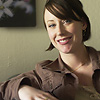Young Woman Breathes Freely After Heart Transplant

Fisher was airlifted from Humboldt County to UCSF Medical Center, where she was put on an intra-aortic balloon pump, a temporary device for critically ill people that increases blood flow to the heart muscle and decreases the heart's workload. After two days, her doctors recommended lifesaving surgery: connecting her to a paracorporeal ventricular assist device (PVAD) - a mechanical device that assists the heart. The PVAD can be used either as a bridge-to-transplant therapy for patients waiting for a heart transplant or as bridge-to-recovery therapy with removal of the ventricular assist device (VAD). Another kind of implantable VAD can be used as a permanent therapy. Because both sides of Fisher's heart - the right and left ventricles - were not functioning properly, she had a biventricular assist device (BiVAD) implanted to help support her heart. After surgery and once she was stabilized, a treadmill was put in Fisher's room to help her strengthen her heart and cardiovascular system. With the BiVAD, patients are normally able to recover at home and resume a normal lifestyle. "At first, I was taking tiny, baby steps on the treadmill," Fisher says. "Then I was able to wear shoes and walk normally. And then, believe it or not, I started running." One of her nurses was a former Ironman triathlete and helped design workouts for her. Part of the Family
During her time in the hospital, Fisher developed very close and lasting relationships with her nurses, especially Jonathan Pascual and Christy Feigenbutz, and with her doctors - Preben Brandenhoff, Donald Hill and Charles Hoopes - and considers them part of her family. At first, Fisher recorded every single thing each person did for her in a notebook to remember to thank them. "But it was impossible to keep track," says Fisher, laughing. "Everyone was so good to me and did so much for me. This whole experience taught me about the goodness and generosity of people." In late 2005, Fisher was readmitted to UCSF in preparation for a heart transplant, which was performed by Hoopes in December. "I was so scared before my transplant, but all of the doctors and nurses came in and assured me that everything would be all right," says Fisher. "One of my nurses and my VAD coordinator even stayed in the operating room the whole time to be sure everything went OK." Fisher's transplanted heart was considered high risk because she had a high panel reactive antibody (PRA) level, a measure of her compatibility with a donor organ. However, her surgery was a success, and Fisher was able to walk the very next day. Remarkable Recovery
"Ila's recovery after transplant has been remarkable, and is in large part the result of her mental toughness and her capacity to deal with the physical and psychological stress associated with long-term VAD implantation and removal," says Hoopes, a specialist in the surgical management of end-stage heart and lung disease. Fisher now attends the Academy of Art University in San Francisco, where she expresses herself and her experience through art, maybe even incorporating some of her old medical supplies into her creations. And at some point, she'd like to help other people facing a similar experience. "Now I feel like this is the heart I'm supposed to have; my old heart was so heavy and I was always conscious of it," says Fisher. "Before, I was always thinking about how much time I had left. Just to be able to breathe without having a machine attached to me is so much to be thankful for. I feel like I have a whole new life, and I'm so grateful." For more information on UCSF Medical Center, visit the website at www.ucsfhealth.org. To find a doctor, call the Physician Referral Service at 888/689-UCSF (888/689-8273). Photo by Christine Jegan